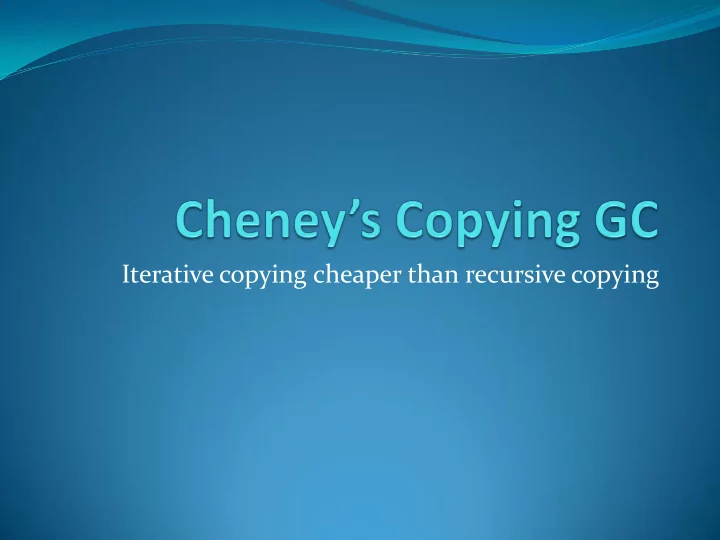

Iterative copying cheaper than recursive copying
Allocation in copying collector init() { to_space = Heap_bottom space_size = Heap_size / 2 top_of_space = to_space + space_size from_space = top_of_space + 1 free = to_space } new(n){ if (free + n > top_of_space) {flip()} if (free + n > top_of_space) { abort “Memory exhausted”} new_cell = free // allocate() free = free + n return new_cell } 2
Flipping the spaces flip() { to_space, from_space = from_space, to_space top_of_space = to_space + space_size free = to_space for R in Roots R = copy(R) // Root pointer now points to copy of R } 3
Copying for variable-sized objects // P points to memory location, not an address copy(P) { if (atomic(P) or P == nil) return P // P is not a pointer if not forwarded(P) // P stores a forwarding address after copied n = size(P) P ´ = free // reserve space in to_space for copy of P free = free + n temp = P[0] // P[0] holds forwarding address forwarding_address(P) = P ´ P ´ [0] = copy(temp) // Restore P[0] // Copy each field of P in to P ´ for i = 1 to i = n – 1 P ´ [i] = copy(P[i]) return forwarding_address(P) // Stored in P[0] } 4
Basic copying collector Uses recursive call to copy Recursive calls costs CPU time Recursion stack occupies precious space Alternative: Cheney’s iterative copying collector Just 2 pointers are needed: scan and free Remember branch points of active graph as a queue scan and free point to opposite ends of queue Stored in new semi-space in objects already copied Use tricolor abstraction 5
Cheney’s copying collector Immediately reachable objects form initial queue of objects for a breadth-first traversal scan pointer is advanced from first object location to end of scanned objects. Each encounter of pointer into from-space, pointee is copied to the end of the queue (in to-space) and the pointer to the object is updated 6
Cheney’s copying collector When an object is copied to to-space, a forwarding pointer is installed in the old version of the object The forwarding pointer signifies that the old version of object is obsolete and indicates where to find replica 7
Cheney’s tricolor abstraction Black: Object scanned--object & immediate descendents visited GC finished with black objects, will not visit them again Grey: Object is visited but its descendents may not have been scanned Collector must visit it again White Object not visited and is garbage at end of tracing phase 8
Cheney’s algorithm after the flip A free scan C B D E F G From-space To-space 9
Roots of structure copied A ´ A ´ A free C B scan D E F G From-space To-space 10
A ´ scanned, copying B and C Black nodes have been scanned; grey nodes copied but not scanned A ´ B ´ C ´ A ´ A free B ´ C ´ C B scan D E F G From-space To-space 11
All from-space objects copied Black nodes have been scanned; grey nodes copied but not scanned A ´ B ´ C ´ D ´ E ´ A ´ A F ´ G ´ scan B ´ C ´ C B free D ´ F ´ E ´ G ´ D E F G From-space To-space 12
left(F) updated Black nodes have been scanned; grey nodes copied but not scanned A ´ B ´ C ´ D ´ E ´ A ´ A F ´ G ´ B ´ C ´ C B free scan D ´ F ´ E ´ G ´ D E F G From-space To-space 13
Algorithm terminates A ´ B ´ C ´ D ´ E ´ A ´ A F ´ G ´ B ´ C ´ C B free scan D ´ F ´ E ´ G ´ D E F G From-space To-space 14
Cheney’s algorithm flip() { to_space, from_space = from_space, to_space top_of_space = to_space + space_size scan = free = to_space for R in Roots R = copy(R) // Root pointer now points to copy of R while scan < free for P in children(scan) *P = copy(*P) scan = scan + size(scan) } 15
Cheney’s algorithm copy() { if forwarded(P) return forwarding_address(P) else addr = free move(P free) free = free + size(P) forwarding_address(P) = addr return addr } 16
Multiple-area collection Problem: CPU cost of scavenging depends in part on size of objects Copying small objects no more expensive than marking with bitmap Cost of copying large objects may be prohibitive Typically contains bitmaps and strings (atomic) Solution: Use large object space (separate memory region) Assume objects have header and body Keep header in semi-space Keep body in large object space (use mark-sweep) 17
Multiple-area collection Problem: Some objects may have some permanence Repeatedly copying such objects is wasteful Solution: Use separate static area Do not garbage collect such region Trace region for pointers to heap object outside static area Preview for generational garbage collection 18
Incrementally compacting collector Divide heap into multiple separately managed regions Allows compacting of parts of the heap Use mark-sweep or other approach on other regions Lang and Dupont: Divide heap into n + 1 equally sized segments At each GC cycle: Choose 2 regions for copying GC Mark-sweep other regions Rotate regions used for copying GC Collector chooses which transition to take next Give preference to mark-sweep to limit growth of stack 19
Effects of incremental compactor Compact small fragments into single piece Compactor will pass through every segment of the heap in n collection cycle Small cost: extra segment used for a semi-space 20
Recommend
More recommend